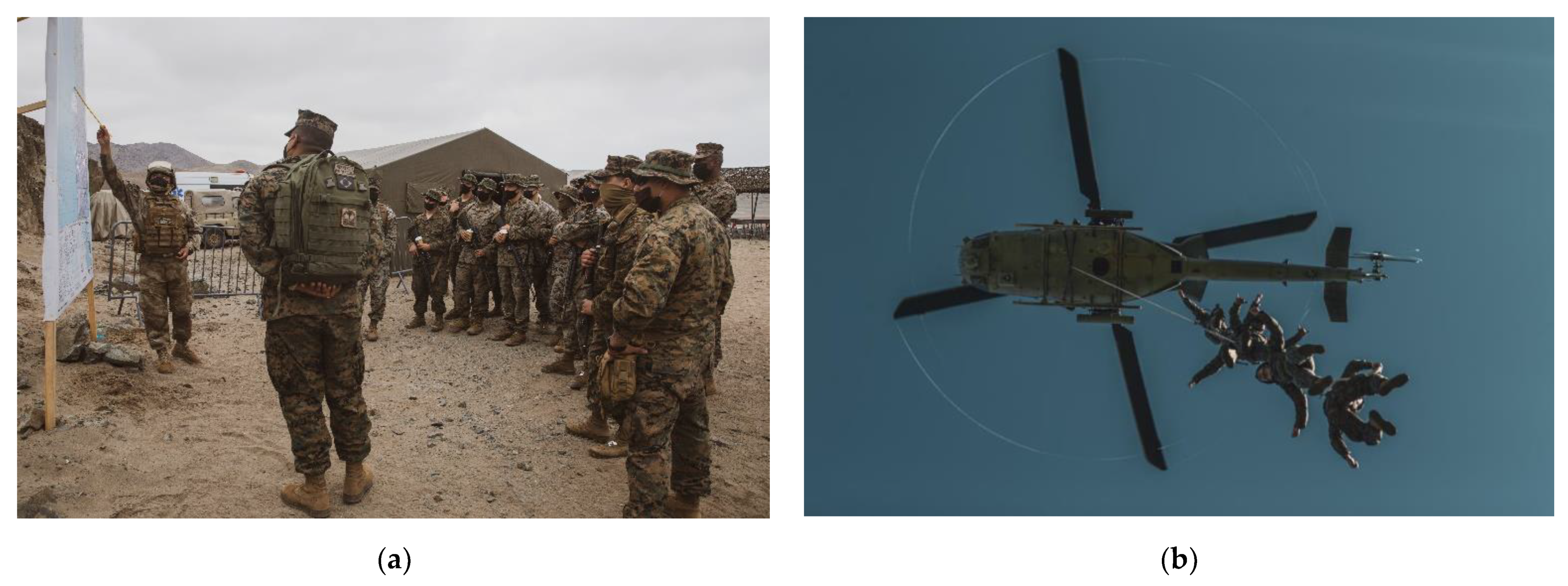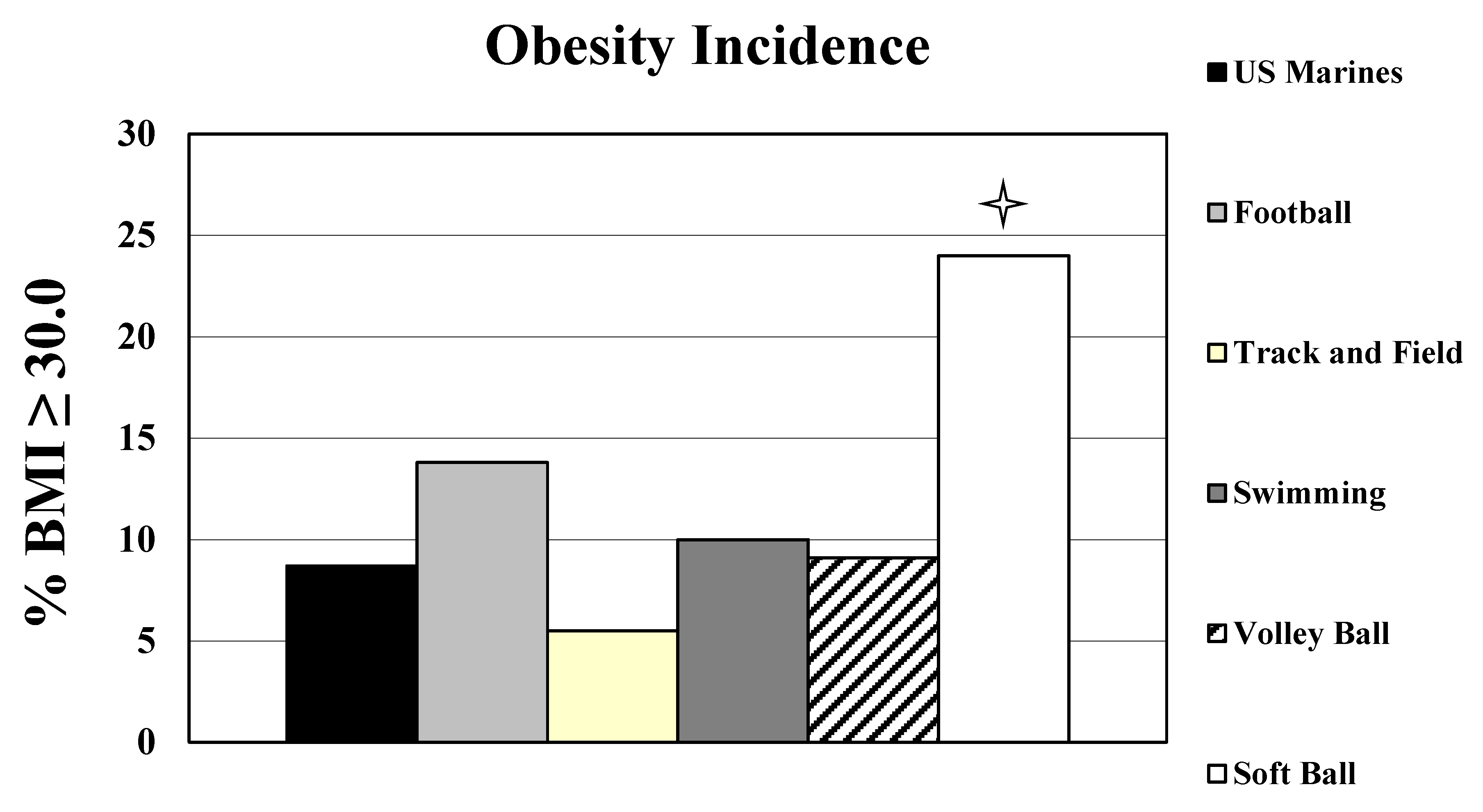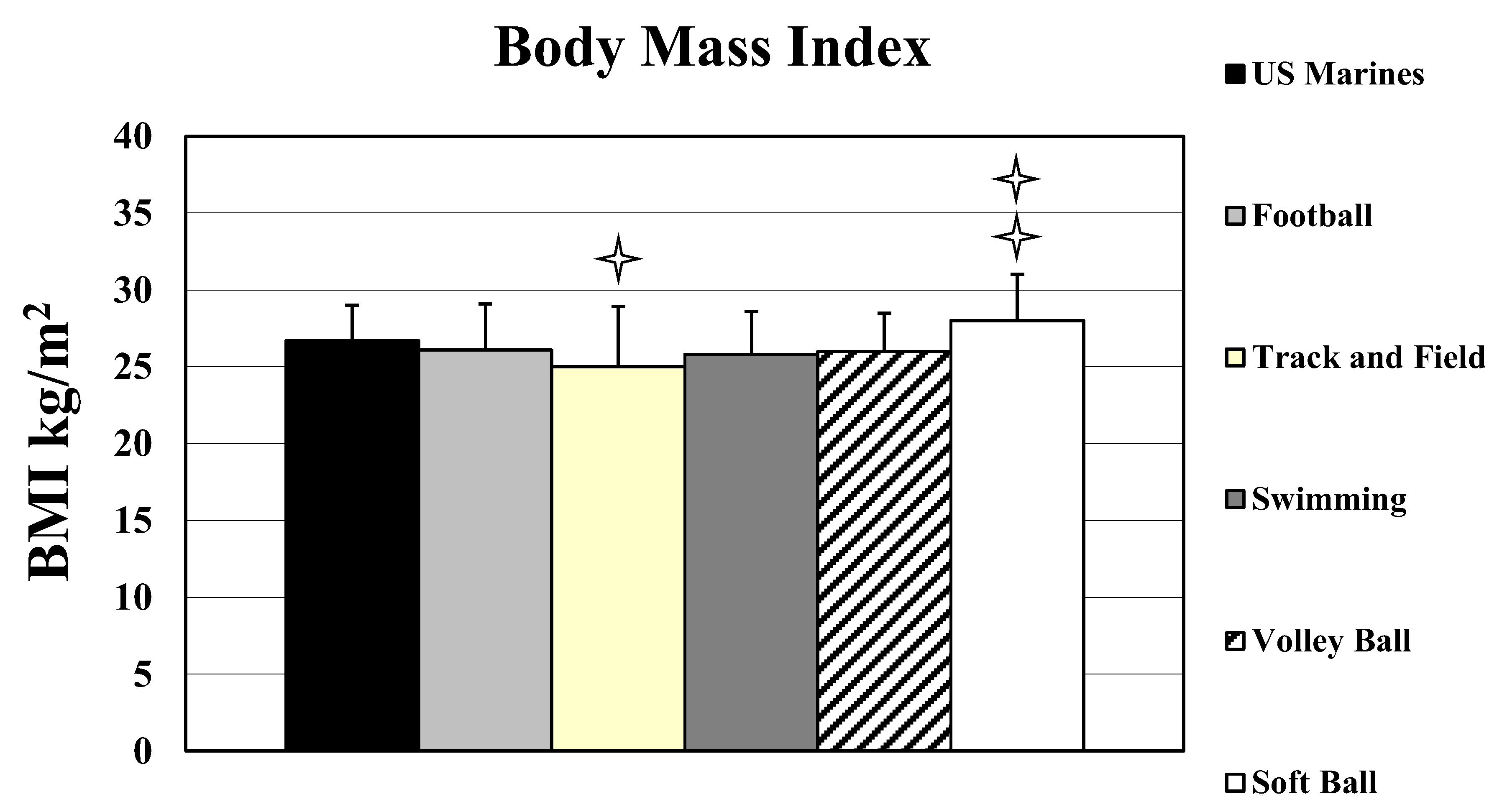Tactical Masters Athletes: BMI Index Classifications
Abstract
:1. Introduction
- the obesity incidence of US male adults 40–59 years was compared to that of Active Duty Enlisted US Marines 46–50 years of age;
- the obesity incidence of North American MA was compared to that of Active Duty Enlisted US Marines 46–50 years of age; and
- the average BMI was compared between Active Duty Enlisted US Marines 46–50 years of age and North American MA.
2. Materials and Methods
2.1. Participants
2.2. Analysis
3. Results
4. Discussion
Author Contributions
Funding
Institutional Review Board Statement
Informed Consent Statement
Data Availability Statement
Acknowledgments
Conflicts of Interest
References
- National Heart, Lung, and Blood Institute. Managing Overweight and Obesity in Adults: Systematic Evidence Review from the Obesity Expert Panel. 2013. Available online: https://www.nhlbi.nih.gov/sites/default/files/media/docs/obesity-evidence-review.pdf (accessed on 1 December 2021).
- Li, T.Y.; Rana, J.S.; Manson, J.E.; Willett, W.C.; Stampfer, M.J.; Colditz, G.; Rexrode, K.; Hu, F.B. Obesity as compared with physical activity in predicting risk of coronary heart disease in women. Circulation 2006, 113, 499–506. [Google Scholar] [CrossRef] [PubMed] [Green Version]
- Hsu, C.Y.; McCulloch, C.E.; Iribarren, C.; Darbinian, J.; Go, A.S. Body mass index and risk for end-stage renal disease. Ann. Intern. Med. 2006, 144, 21–28. [Google Scholar] [CrossRef] [PubMed]
- World Health Organization. Obesity and Overweight. 2021. Available online: https://www.who.int/news-room/fact-sheets/detail/obesity-and-overweight (accessed on 1 December 2021).
- Hales, C.M.; Carroll, M.D.; Fryar, C.D.; Ogden, C.L. Prevalence of Obesity and Severe Obesity among Adults: United States, 2017–2018; NCHS Data Brief, no 360; National Center for Health Statistics: Hyattsville, MD, USA, 2020.
- Walsh, J.; Climstein, M.; Heazlewood, I.T.; Burke, S.; Kettunen, J.; Adams, K.; DeBeliso, M. Variations in body mass index with age in masters athletes (World Masters Games). WASET 2011, 7, 1115–1119. [Google Scholar]
- Walsh, J.; Heazlewood, I.T.; Climstein, M.; Burke, S.; Adams, K.; DeBeliso, M.; Kettunen, J. Body mass index for Australian athletes participating in rugby union, soccer and touch football at the World Masters Games. WASET 2011, 7, 1119–1123. [Google Scholar]
- Climstein, M.; Walsh, J.; Heazlewood, I.T.; DeBeliso, M.; Adams, K.; Burke, S.; Kettunen, J. Obesity prevalence in master’s basketball players. In Proceedings of the 5th Exercise and Sports Science Australia Conference and the 7th Sports Dieticians Australia update, Gold Coast, Australia, 19–21 April 2012. [Google Scholar]
- Walsh, J.; Heazlewood, I.T.; DeBeliso, M.; Climstein, M. Comparison of obesity prevalence across 28 World Masters Games sports. Sport Sci. Int. Sci. J. Kin. 2018, 11, 30–36. [Google Scholar]
- DeBeliso, M.; Sevene, T.G.; Walsh, J.; Adams, K.J.; Kettunen, J.; Heazlewood, I.T.; Climstein, M. Body mass index of North American participants at the World Masters Games. J. Sport Sci. 2014, 2, 189–194. [Google Scholar]
- Walsh, J.; Climstein, M.; Heazlewood, I.T.; Kettunen, J.; DeBeliso, M.; Adams, K.J. Body mass index for athletes participating in swimming at the world Masters Games. J. Sports Med. Phys. Fit. 2013, 53, 162–168. [Google Scholar]
- Walsh, J.; Climstein, M.; Heazlewood, I.T.; DeBeliso, M.; Adams, K.J.; Burke, S.; Juttunen, J. Obesity prevalence in World Masters Games basketball players. Med. Sport. 2011, VII, 1700–1705. [Google Scholar]
- DeBeliso, M.; Walsh, J.; Adams, K.J.; Climstein, M.; Heazlewood, I.T.; Burke, S.; Kettunen, J. Body mass index of North American participants at the World Masters Games. Med. Sci. Sports Exerc. 2012, 44, S143. [Google Scholar]
- Walsh, J.; Climstein, M.; Burke, S.; Kettunen, J.; Heazlewood, I.T.; DeBeliso, M.; Adams, K.J. Obesity prevalence for athletes participating in soccer at the World Masters Games. ISMJ 2012, 13, 76–84. [Google Scholar]
- Sefton, J.M.; Burkhardt, T.A. Introduction to the tactical athlete special issue. JAT 2016, 51, 845. [Google Scholar] [CrossRef] [Green Version]
- Albrecht, A. Marine Corps HIIT Program Focuses on Tactical Athletes. 2014. Available online: https://www.marines.mil/News/News-Display/Article/535339/marine-corps-hitt-program-focuses-on-tactical-athletes/ (accessed on 1 December 2021).
- Keefer, M.; DeBeliso, M. A comparison of United States Marine Corps physical fitness test and combat fitness test results. Int. J. Exerc. Sci. 2020, 13, 1741–1755. [Google Scholar] [CrossRef] [PubMed]
- Keefer, M.; Adams, K.J.; Climstein, M.; DeBeliso, M. The relationship between physical fitness and combat fitness among female United States Marines: A brief report. Int. J. Eng. Investig. 2021, 10, 9–12. [Google Scholar]
- Navalta, J.W.; Stone, W.J.; Lyons, T.S. Ethical issues relating to scientific discovery in exercise science. Int. J. Exerc. Sci. 2019, 12, 1–8. [Google Scholar] [PubMed]
- McDonald, J.H. Handbook of Biological Statistics, 3rd ed.; Sparky House Publishing: Baltimore, MD, USA, 2014. [Google Scholar]
- AlTarawneh, G.; Thorn, S. A Pilot Study Exploring Spreadsheet Risk in Scientific Research. arXiv 2017, arXiv:1703.09785. [Google Scholar]
- Jones, K.; DeBeliso, M.; Sevene, T.G.; Berning, J.M.; Adams, K.J. Body mass index and army physical fitness test standards in ROTC cadets. Int. J. Sci. Eng. Investig. 2012, 1, 54–58. [Google Scholar]
- Palmer, R.; DeBeliso, M. The relationship between soldier height, weight and army combat fitness scores. Int. J. Exerc. Sci. 2021; submitted. [Google Scholar]
- Pryor, J.; Larson, A.; DeBeliso, M. The prevalence of depression and concussions in semi-professional and professional football players. JLM 2016, 6, 7–15. [Google Scholar] [CrossRef] [PubMed] [Green Version]
- Office of the Commandant of the Marine Corps. Marine Corps Body Composition and Military Appearance Program; (MCO 6110.3A w/CH3); Department of Defense: Washington, DC, USA, 2021. Available online: https://www.fitness.marines.mil/BCP_Standards/ (accessed on 1 December 2021).
- The Centers for Disease Control and Prevention. Unfit to Serve: Obesity Is Impacting National Security. 2021. Available online: https://www.cdc.gov/physicalactivity/downloads/unfit-to-serve.pdf (accessed on 1 December 2021).
- Reyes-Guzman, C.M.; Bray, R.M.; Forman-Hoffman, V.L.; Williams, J. Overweight and obesity trends among active duty military personnel: A 13-year perspective. Am. J. Prev. Med. 2015, 48, 145–153. [Google Scholar] [CrossRef] [PubMed]
- Shiozawa, B.; Madsen, C.; Banaag, A.; Patel, A.; Koehlmoos, T. Body mass index effect on health service utilization among active duty male united states army soldiers. Mil. Med. 2019, 184, 447–453. [Google Scholar] [CrossRef] [PubMed] [Green Version]
- Wells, J.C.; Fewtrell, M.S. Measuring body composition. Arch. D Child. 2006, 91, 612–617. [Google Scholar] [CrossRef] [PubMed] [Green Version]



| Marines | Age (y) | Height (m) | Mass (kg) | BMI (kg/m2) |
|---|---|---|---|---|
| Male (n = 402) | 47.2 ± 1.2 | 1.76 ± 0.07 | 83.2 ± 10.0 | 26.7 ± 2.3 |
| BMI (kg/m2) | |||||
|---|---|---|---|---|---|
| Context | Underweight % BMI < 18.5 | Normal % BMI = 18.5–24.9 | Overweight % BMI = 25.0–29.9 | Obese BMI ≥ 30.0 | Average BMI |
| US Marines 1 n = 402 | 0.0 | 18.2 | 73.1 | 8.7 * | 26.7 ± 2.3 |
| Football 2 n = 29 | 0.0 | 44.8 | 41.4 | 13.8 * | 26.1 ± 3.0 |
| Track & Field 2 n = 73 | 1.4 | 0.0 | 93.2 | 5.5 * | 25.0 ± 3.9 *** |
| Swimming 2 n = 20 | 0.0 | 40.0 | 50.0 | 10.0 * | 25.8 ± 2.8 |
| Volley Ball 2 n = 33 | 0.0 | 36.4 | 54.5 | 9.1 * | 26.0 ± 2.5 |
| Soft Ball 2 n = 25 | 0.0 | 12.0 | 64.0 | 24.0 *,** | 28.0 ± 3.0 *** |
Publisher’s Note: MDPI stays neutral with regard to jurisdictional claims in published maps and institutional affiliations. |
© 2022 by the authors. Licensee MDPI, Basel, Switzerland. This article is an open access article distributed under the terms and conditions of the Creative Commons Attribution (CC BY) license (https://creativecommons.org/licenses/by/4.0/).
Share and Cite
Keefer, M.; Walsh, J.; Adams, K.; Climstein, M.; Harris, C.; DeBeliso, M. Tactical Masters Athletes: BMI Index Classifications. Sports 2022, 10, 22. https://doi.org/10.3390/sports10020022
Keefer M, Walsh J, Adams K, Climstein M, Harris C, DeBeliso M. Tactical Masters Athletes: BMI Index Classifications. Sports. 2022; 10(2):22. https://doi.org/10.3390/sports10020022
Chicago/Turabian StyleKeefer, Marc, Joe Walsh, Kent Adams, Mike Climstein, Chad Harris, and Mark DeBeliso. 2022. "Tactical Masters Athletes: BMI Index Classifications" Sports 10, no. 2: 22. https://doi.org/10.3390/sports10020022
APA StyleKeefer, M., Walsh, J., Adams, K., Climstein, M., Harris, C., & DeBeliso, M. (2022). Tactical Masters Athletes: BMI Index Classifications. Sports, 10(2), 22. https://doi.org/10.3390/sports10020022







